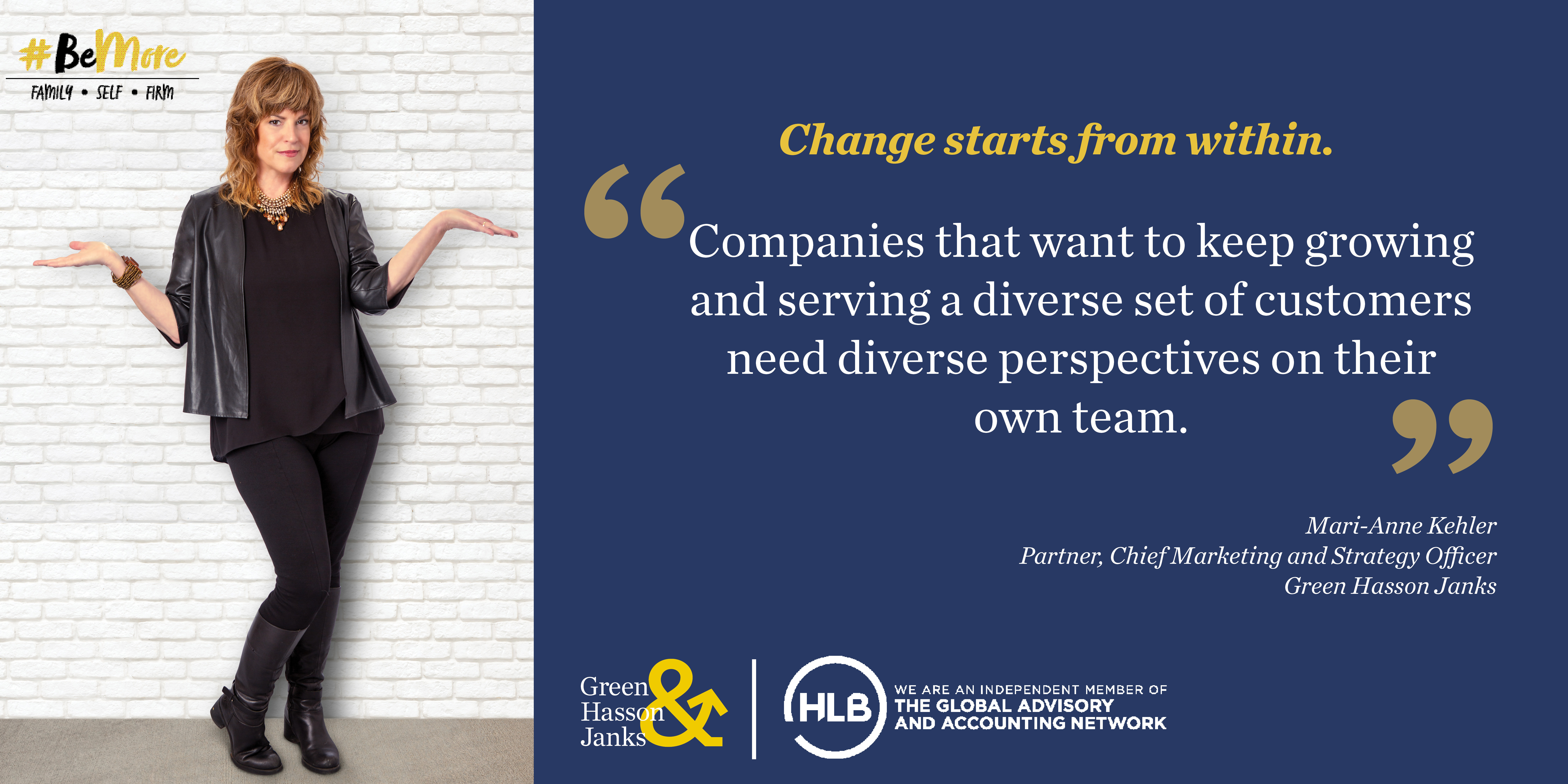Originally published in Boss Magazine
A popular television show auditions talented singers but the judges can’t see them. The focus is on finding people with the best voices. When the judges eventually turn around to see the contestants, they are sometimes surprised. Similarly, businesses might see a resume and then be surprised by a number of factors when the candidate shows up in person, which can derail a very-qualified candidate’s chances.
Ironically, executives often lament the lack of talent, but the “war for talent” might just be a misconception because businesses are only looking for people within a too-narrow talent pool. It is time to throw out any misconceptions that can affect hiring and open up the talent pool to a broader population. Companies that want to keep growing and serving a diverse set of customers need diverse perspectives on their team. A well-considered, inclusive hiring approach is a first step that will pay dividends.
Transform the Culture
Incorporating a diverse staff and varied perspectives usually means making some changes to an organization’s culture. Fostering a culture that embraces diversity is a powerful way to attract great employees. According to research by Glassdoor, 67 percent of job seekers said that a diverse workforce is an important factor to them when considering companies and job offers. It is not just diverse candidates that care – Millennials, for example, have been known to take very principled stands on the issue.
Change the Definition of Diversity
Change starts from within. A company needs to thoughtfully define its definition of diversity and think deeply about how it can bring those people in to work successfully. For physical disabilities, the world has advanced significantly and there are programs and technology available to help people who are in wheelchairs, blind, autistic, epileptic or have any number of other disabilities. Disabled workers can be happy and successful with a accommodations to their working environment.
Make job listings neutral so diverse candidates will not get discouraged or turned off. Define the core qualifications for the job. As an example, according to Forbes, women will often only apply for jobs when they meet 100 percent of the qualifications, while men generally apply if they meet only 60 percent.

Find Diverse Candidates
A company should reach out to groups that represent its diversity goals. For example, Los Angeles-based accounting firm GHJ teamed up with The Mom Project to hire women that will work remotely and thus have the flexibility they need as working mothers. The Mom Project is a digital talent marketplace and community that connects professionally accomplished women with world-class companies.
Search for people in new places. Strategies for reaching people have changed in recent years, and now social media ads are cost effective and highly targeted. Post jobs on new and different job boards that support the job search efforts of women, minorities and other diverse populations like Diversity.com, PDN Recruits, Black Jobs, Hispanic/Latino Professionals Association, Power to Fly, WorkForce 50, Recruit Disability, Female Executive Search, or VetJobs.
A company should consider adding a page to its website that focuses on diversity hiring like Microsoft. Consider attending networking events and charity fundraisers sponsored by organizations that serve underrepresented audiences. If a business traditionally focuses on campus recruiting, look at new schools beyond its immediate area, community colleges, trade schools or schools that serve diverse students.
Who is actually interviewing candidates? Consider diverse interviewers or panels of interviewers. Working Mother Magazine reports that diverse interview teams have made a noticeable difference at the semiconductor chip producer Intel. Since the firm’s 2014 decision to require “at least two women and/or members of underrepresented minorities” on its interview panels, Intel’s diversity among new hires has significantly increased from 31.9 percent women or people of color in 2014 to 45.1 percent in 2016.
Overcome Unconscious Bias
Everyone has some sort of bias and many times it is subconscious. People all can make assumptions based on a person’s looks, age, ethnicity or apparent disability. This can be due to the brain’s tendency to create shortcuts, which is simply muscle memory. Reducing this type of bias takes commitment and work. Employees should go through regular training and see the commitment to diversity demonstrated by leadership.
Sadly, research has shown that African American and Asian job applicants who mask their race on resumes have better success getting a job interview. Twenty-five percent of African American candidates received interviews after changing their resumes, but only 10 percent got interviews when they left their ethnic details intact. One solution is to make the screening process blind by using pre-assessment tools that can assess specific skills or personality traits or by using artificial intelligence and machine learning that can pull specific data.
Hidden Disabilities
A wheelchair-bound applicant cannot hide a disability, but many cannot be seen. Sexual orientation or religion may not be obvious, and age is hard to determine. Assuring applicants that an organization has a solution can be a delicate process. The Americans with Disabilities Act prohibits asking directly, but interviewers need to know if the applicant can perform the job duties. Often the applicant will bring up something that needs to be known, but in any case an interviewer can ask if the applicant is confident he or she can perform all the job’s responsibilities, which will open up the conversation. Then the interviewer can then ask what the applicant needs to be successful.
Growth is the By-product of Inclusive Hiring
Diversity is good for business. A McKinsey study found that companies in the top quartile for racial and ethnic diversity are 35 percent more likely to have financial returns above their respective national industry medians. The study also found that in the United States there is a linear relationship between racial and ethnic diversity and better financial performance: for every 10 percent increase in racial and ethnic diversity on the senior executive team, earnings before interest and taxes (EBIT) rise 0.8 percent.
In addition, diverse companies have 2.3 times higher cash flow per employee over a three-year period, gender diverse companies are 15 percent more likely to have above-average financial returns and organizations with diverse boards have 95 percent higher returns on equity than their less diverse competitors.
A more diverse staff also improves innovation, and a Harvard Business Review article describes research that found “leaders who give diverse voices equal airtime are nearly twice as likely as others to unleash value-driving insights.”
Conclusion
Inclusive hiring takes a demonstrable corporate commitment, followed up by actions that define a company’s cultural brand. It takes a thoughtful strategy that transforms the entire organization, not just hiring practices. And it takes communication, both within the organization and to potential applicants.
Inclusive hiring leads inevitably to an inclusive culture, and the financial growth that comes from diverse thinking is a compelling reason to embrace it.
Key Takeaways for Success
- Open up an organization’s definition of ability
- Build an inclusive culture
- Keep a business’s brand promise
- Redefine hiring practices to eliminate as much unconscious bias as possible
- Ask diverse employees for suggestions on improving the initiative
- Support local leadership programs that mentor and teach professionals of color
- Consider changing educational requirements and hire non-college grads
- Look to industry peers who are undergoing similar processes and seek advice from those who are succeeding
- Innovate in finding ways to attract diverse employees – consider flexible schedules for working mothers or late career professionals


